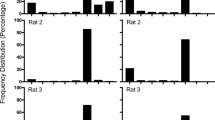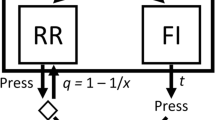Abstract
The lever pressing of five adult, female gerbils was maintained on fixed-interval schedules with interval values of 20, 60, and 180 sec. Performance was characterized by a pause after reinforcement followed by either an acceleration of responding or a constant response rate until the next reinforcer was obtained. Overall response rates and response rates calculated to exclude postreinforcement pauses (running rates) varied unsystematically with changes in the fixed-interval parameter, higher response rates tending to occur with shorter intervals. The average postreinforcement pause durations, however, were systematically related to the interval value, pause durations increasing with increases in the interval size. Gerbils thus show patterns of fixed-interval responding similar to those of other species and appear to be convenient subjects for use in studies of operant behavior.
Similar content being viewed by others
References
CAMPBELL, N., STANEY, D., & NEURINGER, A. 1969. Operant conditioning in the gerbil. Psychonomic Science, 16, 255–256.
CATANIA, A. C, & REYNOLDS, G. S. 1968. A quantitative analysis of the responding maintained by interval schedules of reinforcement. Journal of the Experimental Analysis of Behavior, 11, 327–383.
DUKICH, T.D., & LEE, A.E. 1973. A comparison of measures of responding under fixed-interval schedules. Journal of the Experimental Analysis of Behavior, 20, 281–290.
FERSTER, C. B., & SKINNER, B. F. 1957. Schedules of reinforcement. New York: Appleton-Century-Crofts.
LOWE, C. F., & HARZEM, P. 1977. Species differences in temporal control of behavior. Jo urn al of the Experimental A na lysis of Behavior, 28, 189–201.
LOWE, C. F., HARZEM, P., & BAGSHAW, M. 1978. Species differences in temporal control of behavior Ii: Human performance. Journal of the Experimental Analysis of Behavior, 29, 351–361.
POWELL, R. W., & CURLEY, M. 1976. Instinctive drift in nondomesticated rodents. Bulletin of the Psychonomic Society, 8, 175–178.
SCHNEIDER, B. A. 1969. A two-state analysis of fixed-in ter val responding in the pigeon. Journal of the Experimental Analysis of Behavior, 12, 677–687.
THIESSEN, D., & YAHR, P. 1977. The gerbil in behaviorial investigations. Austin: The University of Texas Press.
VANDER WEELE, D. A., & ABELSON, R. M. 1973. Selected schedules of reinforcement in the Mongolian gerbil. Psychological Reports, 33, 99–104.
VANDER WEELE, D. A., ABELSON, R. M., & TELLISH, J. 1973. A comparison of ratio behavior in the gerbil and white rat. Bulletin of the Psychonomic Society, 1, 62–65.
Author information
Authors and Affiliations
Rights and permissions
About this article
Cite this article
Sanger, D.J. Fixed-Interval Responding in Mongolian Gerbils. Psychol Rec 29, 553–558 (1979). https://doi.org/10.1007/BF03394643
Published:
Issue Date:
DOI: https://doi.org/10.1007/BF03394643




